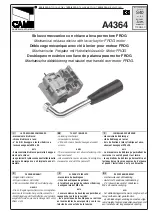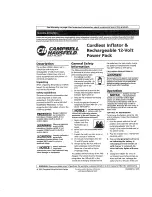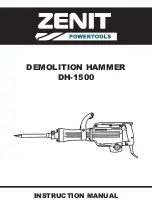
Ergonomics
Ergonomic guidelines
1
) Take frequent breaks and change work positions frequently.
2
) Adapt the workstation area to your needs and the work task.
• Adjust for convenient reach range by determining where parts or tools should be located to avoid static
load.
• Use workstation equipment such as tables and chairs appropriate for the work task.
3
) Avoid work positions above shoulder level or with static holding during assembly operations.
• When working above shoulder level, reduce the load on the static muscles by reducing the weight of the
tool, using for example torque arms, hose reels or weight balancers. You can also reduce the load on the
static muscles by holding the tool close to the body.
• Make sure to take frequent breaks.
• Avoid extreme arm or wrist postures, particularly for operations requiring a degree of force.
4
) Adjust for convenient field of vision by minimizing movement of the eyes and head during the work task.
5
) Use the appropriate lighting for the work task.
6
) Select the appropriate tool for the work task.
7
) Use ear protection equipment in noisy environments.
8
) Use high-quality inserted tools or consumables to minimize exposure to excessive levels of vibrations.
9
) Minimize exposure to reaction forces.
• When cutting:
A cut-off wheel can get stuck if the wheel is either bent or if it is not guided properly. Make sure to use
correct flanges for cut-off wheels and avoid bending the wheel during cut-off operation.
• When drilling:
The drill might stall when the drill bit breaks through. Makes sure you use support handles if the stall
torque is too high. The safety standard ISO11148 part 3 recommends to use something to absorb the reaction
torque above 10 Nm for pistol grip tools and 4 Nm for straight tools.
• When using direct driven screw or nutrunners:
Reaction forces depend on tool setting and joint characteristics. The ability to bear reaction forces depends
on the operator’s strength and posture. Adapt the torque setting to the operator's strength and posture and
use a torque arm or reaction bar if the torque is too high.
10
) Use dust extraction system or mouth protection mask in dusty environments.
Configuration
Tightening torque
For accurate operation and safety, the tightening torque of the screwdriver must be adjusted correctly in relation
to the screw joint. Check the torque specification for the actual joint.
The torque is set by adjusting the clutch spring with the torque key, supplied together with the screwdriver.
Tighten one screw until the clutch releases and the screwdriver stops. If needed, adjust the torque settings.
Verification of tightening torque
Atlas Copco Torque Analyser, ACTA 4000, plus an appropriately-sized in-line transducer, IRTT together with
the available test joints are recommended equipment.
Torque range of the clutch springs :
A
Each clutch spring gives a certain torque range. Don’t adjust the torque over the maximum recom-
mendation as that might result in improper function and faster wear of the clutch.
5
© Atlas Copco Industrial Technique AB - 9836 8184 00
Operation
EN
EBL12






































